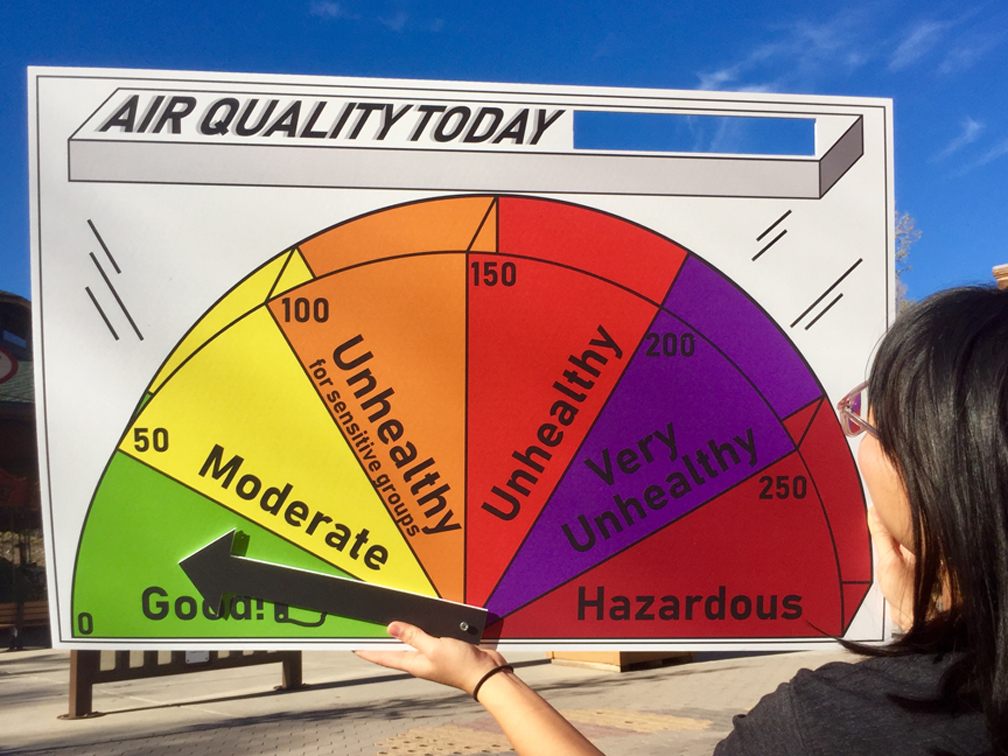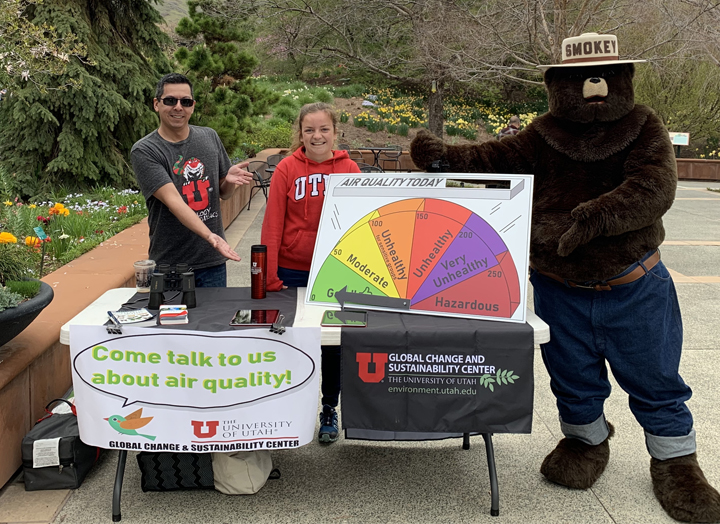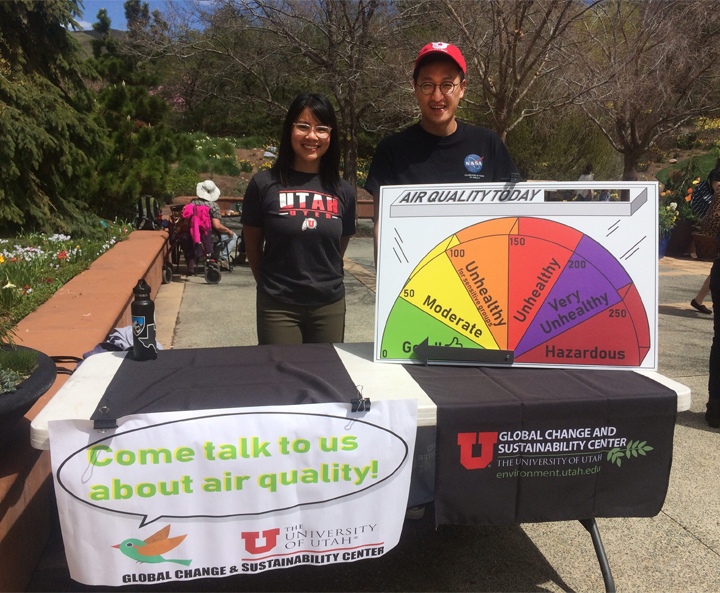
From the semester’s beginning, we focused on air quality as an inhibitor of environmental, social, and economic sustainability along the Wasatch Front. As we ideated technological fixes, the problem of air quality continually related back to communication issues. How is air quality communicated throughout the Salt Lake Valley? Are those methods of communication effective? And, what is a viable point of intervention for increasing public awareness and knowledge? By centering these questions, we developed a two-fold project based on multi-directional communication. We went to public spaces with an air quality questionnaire. Through this engagement, the public informed us with their responses and insights, while we simultaneously informed the public with conversations and a sign depicting current air quality conditions.
The lessons learned and information gathered from this project will live on. The approximately 250 people with whom we interacted can carry on the conversation. Additionally, we presented this project to the Global Change and Sustainability Committee meeting on May 6, 2019. Finally, the survey data gathered will be given to environmental and health-based non-profits as well as academic researchers to help them better understand the public’s awareness of air quality. Hopefully, this can illuminate knowledge gaps and influence policies going forward.
-
Nationwide, more than 4 in 10 Americans – nearly 138.5 million people – live in counties where ozone or particle pollution levels make the air unhealthy to breathe (State of the Air 2015 ). In recent years, many cities have record numbers of days with high short-term particle pollution (particulate matter). This trend has particularly been observed in the Western United States, where drought and heat have increased dust, grass fires, and wildfires. According to the “State of the Air 2015”, a report released by the American Lung Association, Salt Lake Valley’s air quality is worsening. The report ranks Salt Lake City as the 7th-most polluted city in the nation for short-term particle pollution. According to the report, Salt Lake City has also seen a slight increase in year-round particulate matter (soot) levels. This contrasts the nationwide trend of decreasing particle pollution levels.
On average, Salt Lake City experiences 40 days per year where air quality levels, measured either as ozone (smog) or particulate matter pollution, exceed federal government standards (Mitchell et al. 2018). Salt Lake County has received an “F” rating with regard to air quality because of the substantial increase in the number of unhealthy days of short-term particle pollution (State of the Air 2015). Particulate matter can spike dangerously for hours to weeks on end, introducing serious health consequences to those exposed. Particle pollution can penetrate deep into the lungs and even into the bloodstream, leading to premature deaths, asthma attacks, heart attacks, and lung cancer (E.P.A. 2014; Stieb et al. 2018; Lelieveld 2015). The “State of the Air 2015” also found that Salt Lake Valley ozone levels have worsened, resulting in an “F” grade in Salt Lake County. The report states ozone is the most widespread air pollutant, created by the reaction of sunlight on emissions from vehicles, among other sources. When ozone is inhaled, it irritates the lungs, feeling like a bad internal sunburn (State of the Air 2015). It can cause immediate health problems that last several days. For example, ozone can cause wheezing, coughing, asthma attacks and premature death. For both particulate matter and ozone pollution, risk of negative health effects greatly increases under certain conditions, such as engaging in cardio-based exercise or working outdoors (Carlisle & Sharp 2001; E.P.A. 2014). People with pre-existing cardiovascular or respiratory conditions are also at greater risk (E.P.A. 2014). Understanding if and how people learn about air quality conditions and their associated risks is thus of great importance to public health for the Salt Lake community.
-
The immediate objective of this project was to evaluate the general public’s air quality knowledge due to the various associated health consequences. With many new transplants moving into the Salt Lake Valley, many people are unaware of the Valley’s air quality issues. The University of Utah is one means of informing new incoming students to the problems regarding air quality; however, other communities in the Salt Lake Valley may not be privy to such information. After determining the public’s current understanding, air quality communication methods can then be tailored to ensure high effectiveness. Awareness is thus the first step toward solution-oriented policy development and implementation.
In looking at the general public’s knowledge regarding air quality, the problem lies not with the existence of information related to air quality. Resources such as websites, mobile apps, and radio announcements exist that communicate what current air quality conditions are and explain what scientists and health professionals recommend based upon the severity of air pollution. Rather, the problem is that these resources--and therefore their content--are not always communicated effectively. Furthermore, some of the resources provide more accurate information than others. People rarely think to look up environmental conditions beyond basic weather, and hardly ever know which resources to use. Therefore, there is a need to understand how the public learns about air quality, to communicate air quality conditions more effectively, and to reach out to unaware communities.
Improving air quality communication should have a positive long-term effect on the general public. Education and awareness of air quality will directly impact an individual’s mindset and make them more aware of their actions during poor air quality days. They would be more likely to minimize their exposure to health-damaging pollutants by reducing their time spent outdoors. Therefore, with increased access to the most accurate information, individuals can make the best choices for their personal health and wellbeing and that of their loved ones.
The people of Salt Lake Valley will benefit from this project. This includes individuals taking advantage of outdoor recreational activities. Additionally, the homeless community are more likely to be found in one of the many parks around Salt Lake City. Liberty Park is one of these parks where the homeless community can be found around time at certain times. Due to their frequency of being outside they are also most affected by poor air quality days
-
As part of the Air Quality Communication and Awareness group, we intended to start conversations about air quality in Salt Lake City. We aimed to use a survey and conversations to investigate the general communities’ awareness and understanding of air quality and how it impacts their daily lives. We conducted community engagement events at the Hogle Zoo, Liberty Park, and Red Butte Garden. We sent the survey by email to various affiliates of the University of Utah and shared the survey further through Heal Utah’s twitter page. As part of our outreach efforts, we developed an Air Quality sign. This sign, with a design inspired by Smokey the Bear fire danger signs, includes the Air Quality Index values from the Utah Department of Health. The Air Quality Index values are a measure of present day air quality conditions; potential health hazards are associated with the values (Air Pollution and Public Health in Utah).
Community Engagement Events:
Party for the Planet at the Hogle Zoo (April 20, 2019)
One of the community engagement events took place on April 20, 2019 at the Hogle Zoo as part of their “Party for the Planet” event. The Hogle Zoo allowed us participate at their event representing the Global Change and Sustainability Center and the University of Utah. This allowed us to interact and engage with the Salt Lake City community about air quality awareness. Individuals were happy to ask questions and partake in our survey.
Arbor Day at Red Butte Gardens (April 26, 2019)
The second event as part of the air quality awareness project took place on April 26, 2019 at Red Butte Gardens at their Arbor Day Celebration. This was a free event to the local Salt Lake City community. We were able to participate and have a table where we talked to families living in the Salt Lake City valley. We were also able to get additional survey responses from this event that contributed to this project.
Team:
Mikala Jordan, Katherine Bui, Raul Ochoa, Junsik Kim
References:
“Air Pollution and Public Health in Utah.” UtahAir - Conditions, www.health.utah.gov/utahair/AQI/.
“State of the Air 2015.” http://www.stateoftheair.org/2015/assets/ALA_State_of_the_Air_2015.pdf
Mitchell, L.E., Crosman, E.T., Jacques, A.A., et al. 2018. Monitoring of greenhouse gases and pollutants across an urban area using a light-rail public transit platform. Atmospheric Environment 187: 9-23.
Lelieveld, J., Evans, J.S., Fnais, M., Giannadaki, D., and Pozzer, A. 2015. The contribution of outdoor air pollution sources to premature mortality on a global scale. Nature 525: 367-385.
Stieb, D.M., Shutt, R., Kauri, L.M. et al. 2018. Cardiorespiratory Effects of Air Pollution in a Panel Study of Winter Outdoor Physical Activity in Older Adults. Journal of Occupational and Environmental Medicine 60(8): 673-682.
Environmental Protection Agency (E.P.A.). 2014. Air Quality Index: A Guide to Air Quality and Your Health. Research Triangle Park, North Carolina.
Carlisle, AJ and Sharp, NCC. 2001. Exercise and outdoor ambient air pollution. British Journal of Sports Medicine 35: 214-222.



Images, top to bottom:
This air quality sign was developed as a visual display to prompt community engagement at local Salt Lake City events. Air Quality Index values are from the Utah Department of Health.
Raul Ochoa (left) and Mikala Jordan (center) with Smokey the bear at Arbor Day Celebration at Red Butte Gardens.
Raul Ochoa (left) and Mikala Jordan (right) at the Hogle Zoo for Party for the Planet event on April 20, 2019.
Katherine Bui (left) and Junsik Kim (right) at Red Butte Gardens for their Arbor Day Celebration on April 26, 2019.
